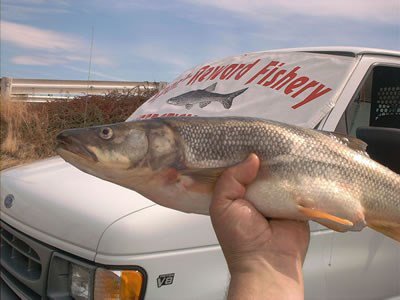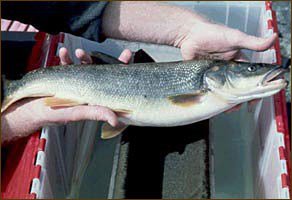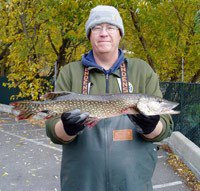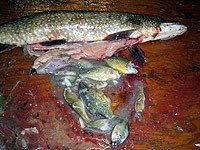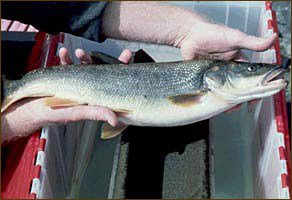While game fish including bass and walleye are known to eat juvenile salmon and steelhead, state and tribal fishery managers are more concerned about two ravenous predator fish in the Columbia River system, northern pike and northern pikeminnow.
Northern pike are present in rivers and lakes in the upper Columbia River Basin, where they prey on resident species and have the potential to derail efforts to restore and rebuild native species such as westslope cutthroat trout and bull trout. Northern pikeminnow are present in the lower river where juvenile salmon and steelhead migrate to the ocean, consuming millions of fish annually. So far, northern pike have not be found there.
There is a sport reward fishery for northern pikeminnow in the lower Columbia and Snake rivers, and similar fisheries are being considered for northern pike.
Northern Pike
Northern pike (see longer story), a voracious predator, appear to be increasing in the northern extreme of Lake Roosevelt near the Canadian border. The fish previously were found in the Pend Oreille River, in the Columbia River in British Columbia, in Lake Coeur d’Alene, and in rivers in western Montana. The fish may be migrating downstream, or they may be being transferred illegally by anglers.
Regardless, it’s bad news because pike are voracious predators on smaller fish, including juvenile trout, kokanee, and other native and non-native species. Their presence anywhere threatens efforts to protect and restore native fish species. Tribes and state fish and wildlife agencies, joined by their counterparts in British Columbia, are mounting an assault on the big fish – they can grow to more than 30 pounds and a meter in length – hoping to halt their spread before they do real damage to recreational and tribal fisheries in Lake Roosevelt, and possibly farther downriver.
Northern pike probably can’t be eliminated, but they can be managed and the population reduced significantly. The Kalispel Tribe, whose reservation borders the Pend Oreille River in Washington, has documented exponential growth of the population from 400 adult fish in 2006 to 5,500 in 2010, along with an expansion of their range within the river.
Pike were first detected in Lake Roosevelt, the reservoir behind Grand Coulee Dam, in 2009, and they are not welcome, as they prey on salmonids that are being raised for fisheries and restoration purposes. Their preference for salmonids is not good news for Lake Roosevelt, where rainbow trout, mountain whitefish, and kokanee – all salmonids -- made up 76 percent of the pike diet in the reservoir in one study. Significant investments in fish restoration in the Columbia and Pend Oreille rivers are aimed at salmonids.
Fishery managers in British Columbia and Washington began working to suppress pike in 2012. Pike are popular with recreational fishers; there is no catch limit in Idaho or Washington. So far the best fishing, and therefore the highest concentration of pike, has been in the Columbia near Kettle Falls, and in its Kettle River tributary.
The Council is concerned about the proliferation of northern pike because of the potential to disrupt and set back ongoing electricity ratepayer-funded efforts to restore fish runs and enhance fisheries throughout the Columbia River Basin. If the downstream migration continues, pike could threaten salmon and steelhead recovery and reintroduction efforts downstream of Chief Joseph Dam.
State fishing regulations place no limits on pike angling. Anglers are encouraged to not release live fish after capture.
Northern Pikeminnow
Northern pikeminnow, a type of dace, are a ravenous predator of juvenile salmon and steelhead in the Columbia River. Northern pikeminnow are native to the Columbia River. Reservoirs behind dams create ideal habitat for these fish, and the construction of the Columbia River Basin hydropower system combined with the presence of millions of juvenile salmon and steelhead caused the pikeminnow population to skyrocket.
Until 1998, northern pikeminnow were known as squawfish. That year, the American Fisheries Society officially changed the name.
Northern pikeminnow can live longer than 15 years, reach more than 24 inches in length, and weigh up to eight pounds. As they mature and grow larger, they consume more and more salmon and steelhead smolts. Reducing predation by large fish on smaller fish is difficult, to say the least, and individual species can’t be targeted except through directed fisheries.
Accordingly, since 1990 the Bonneville Power Administration has funded, through the Council’s Columbia River Basin Fish and Wildlife Program, a sport reward fishery that pays a bounty for each fish over a certain size. The goal of the program is not to eliminate northern pikeminnow, but rather to reduce the average size and curtail the number of larger, older fish.
The season runs annually in the lower Columbia River (mouth to Priest Rapids Dam) and the Snake River (mouth to Hells Canyon Dam). Anglers can bring fish to any of 20 registration stations in Washington and Oregon and must follow specific rules consistent with state fishing regulations. Anglers are paid for each northern pikeminnow nine inches or larger, and the more fish caught, the higher the reward. Rewards begin at $5 each for the first 25 fish, then go to $6 each for 26 to 200 fish, then to $8 each for every fish caught above 200. There even is a specially tagged northern pikeminnow annually worth $500.
According to the Washington Department of Fish and Wildlife, which provides weekly updates of angling success on its website, in 2014 the top 20 anglers caught an average of about 3,500 fish each and averaged reward payments of $28,609 each for the five-month season. The highest paid angler earned $73,698. Results indicate the program is successful. Since 1990, more than 4.2 million northern pikeminnow have been removed by the Sport Reward Fishery, reducing predation on juvenile salmon and steelhead by an estimated 40 percent.




